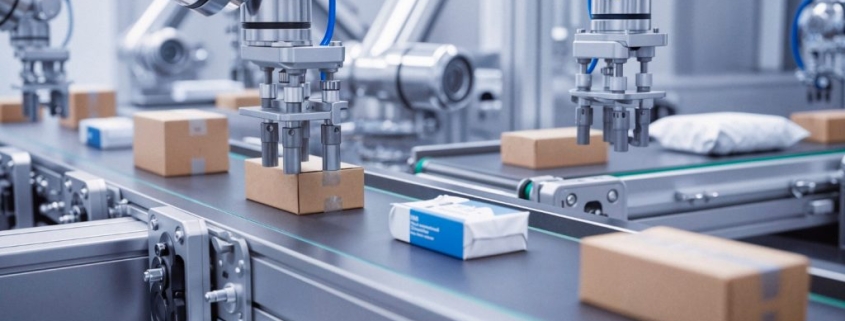Seamless Product Delivery: The Rise of Automation Technology

In an era where speed and efficiency reign supreme, the expectation for swift and accurate product delivery has never been higher. Behind the scenes of this dynamic shift lies a silent revolution — automation technology. Seamlessly weaving together robotics, artificial intelligence, and smart logistics, automation is reshaping the way goods move from production lines to customers’ doorsteps. This transformation not only accelerates delivery times but also enhances precision and reliability, setting new standards in the world of supply chain management. As we explore the rise of automation technology, we uncover how it is turning the complex puzzle of product delivery into a smooth, effortless experience for businesses and consumers alike.
The Evolution of Automation in Modern Product Delivery
Automation has transformed the way products reach consumers, turning complex logistics into a finely tuned symphony of efficiency. Early methods relied heavily on manual tracking and human coordination, which were frequently enough prone to errors and delays. Today, advanced systems harness technologies like AI-driven route optimization, real-time inventory management, and autonomous delivery vehicles to ensure not just speed, but a consistent quality in service. These innovations enable businesses to adapt dynamically to fluctuating demands, improve accuracy, and reduce operational costs — all while enhancing the customer experience.
The rise of automation has brought with it a spectrum of tools that revolutionize every step of the supply chain. Key developments include:
- Robotic sorting centers that rapidly categorize goods without human intervention
- Smart warehouses employing IoT sensors for precise stock monitoring
- Predictive analytics forecasting demand patterns to prevent bottlenecks
- Contactless delivery systems leveraging drones and autonomous vehicles
To illustrate how automation has progressively improved delivery metrics, the table below compares conventional and automated delivery KPIs:
| Metric | Traditional Delivery | Automated Delivery |
|---|---|---|
| Average Delivery Time | 3-5 Days | Same Day or Less |
| Error Rate | 7% | 1.5% |
| Operational Cost | High | Moderate to Low |
| Customer Satisfaction | 70% | 90%+ |
Key Technologies Driving Seamless Integration and Efficiency
At the heart of modern automated product delivery are technologies that not only connect disparate systems but also optimize workflows in real time. among these, Artificial Intelligence (AI) stands out by enabling predictive analytics and intelligent decision-making, allowing supply chains to adjust dynamically to changing demands. Coupled with Internet of Things (IoT) devices, facilities gain constant insight into inventory status and equipment health, creating a tightly woven network of communication that prevents delays before they occur. Meanwhile, Robotic Process Automation (RPA) handles repetitive tasks with precision, freeing human resources to focus on strategy and innovation.
To better illustrate the impact, consider key technologies and their primary functions:
| Technology | Core Benefit | Submission Area |
|---|---|---|
| AI & Machine Learning | Predictive Analytics and Optimization | Demand Forecasting, Route Planning |
| IoT Sensors | Real-time Monitoring and Alerts | Inventory Tracking, Equipment Status |
| Robotic Process Automation | Automation of Routine Tasks | Order Processing, Billing |
| Cloud Computing | Scalable Data Storage and Integration | Data Sharing Across Platforms |
Integration platforms leveraging cloud-based APIs unify these technologies seamlessly, ensuring data flows effortlessly between systems, from warehouse management to last-mile delivery. This integration reduces manual intervention, diminishes error rates, and accelerates turnaround times, ultimately crafting a streamlined delivery experience that meets the demands of today’s fast-paced market.
Overcoming Challenges in Automated Supply Chains
Navigating the complexities of automated supply chains requires more than just integrating cutting-edge technology; it demands strategic foresight and adaptability. One major hurdle lies in system interoperability, where diverse platforms and devices must communicate flawlessly to maintain workflow continuity. To address this, businesses are investing in advanced middleware solutions that act as translators, ensuring smooth data exchange between legacy systems and modern automation software. Additionally, managing real-time data with precision is crucial, as even minor delays or inaccuracies can cascade into significant operational disruptions.
Beyond technical challenges, the human factor remains a critical element. Reskilling the workforce to oversee and collaborate with automated processes is essential to avoid bottlenecks. Companies are adopting extensive training programs focusing on:
- Data literacy and analytics interpretation
- Robotics and machinery troubleshooting
- Cybersecurity awareness
Below is a snapshot of common obstacles versus effective responses adopted by leading organizations:
| Challenge | Innovative Solution |
|---|---|
| Inconsistent Data Streams | Predictive Analytics With AI Algorithms |
| System Downtime | 24/7 Automated Monitoring & Quick Response Teams |
| Employee Resistance | Continuous Upskilling and Collaborative Culture |
Best Practices for Implementing Automation to Maximize Delivery Performance
To harness the full potential of automation in enhancing delivery performance, it is essential to adopt a strategic approach that balances technology with human oversight. Start by mapping out all critical delivery touchpoints and identifying repetitive, time-consuming tasks ripe for automation. This not only reduces human error but also accelerates turnaround times. Integration with existing systems is key; ensure that automation tools seamlessly communicate with inventory, order management, and customer service platforms to create a unified workflow. Additionally, continually monitor key performance indicators (KPIs) such as delivery accuracy, speed, and customer satisfaction, using real-time dashboards to make data-driven adjustments on the fly.
Collaboration between departments fuels successful automation implementation. Engage cross-functional teams early to foster buy-in and leverage diverse insights for process refinement. Train staff to adapt and work alongside automation, focusing on skills that complement machine efficiency, like problem solving and exception management. Below is a quick reference checklist for best practices that can streamline your rollout:
- Audit Processes: Identify automation opportunities through detailed process evaluations.
- Choose Scalable Tools: Select platforms that grow with your business demands.
- Test Incrementally: Deploy automation in phases to minimize disruption.
- Measure Impact: Use KPIs and customer feedback to refine operations continually.
- Maintain Flexibility: Stay prepared to reconfigure systems as priorities evolve.
| Best Practice | Key Benefit |
|---|---|
| Process Auditing | Identify Bottlenecks Early |
| Scalable Automation Tools | Supports Growth and Evolving Needs |
| Incremental Rollout | Minimizes Risk and Downtime |
| Real-Time Performance Monitoring | Enables Proactive Adjustments |
| Cross-Functional Training | Enhances Team Adaptability |
Final Thoughts…
As automation technology continues to weave itself into the fabric of product delivery, the line between possibility and reality grows ever thinner. The seamless flow from warehouse to doorstep is no longer a distant aspiration but an unfolding narrative — one where efficiency, precision, and innovation coalesce. While challenges remain, the rise of automation promises a future where products arrive not just on time, but with a newfound harmony between human ingenuity and technological prowess. In this evolving landscape, businesses and consumers alike stand to benefit from a delivery experience reimagined for the modern age.



![[Aggregator] Downloaded image for imported item #1292](https://ecomedgedigest.com/wp-content/uploads/2025/09/IMG_0808-1024x683-1-180x180.jpeg)


![[Aggregator] Downloaded image for imported item #1376](https://ecomedgedigest.com/wp-content/uploads/2025/10/IMG_0953-1024x770-1-180x180.jpeg)
![[Aggregator] Downloaded image for imported item #1357](https://ecomedgedigest.com/wp-content/uploads/2025/09/IMG_0893-1024x681-1-180x180.jpeg)


Leave a Reply
Want to join the discussion?Feel free to contribute!